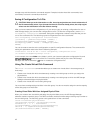
Before running the autoConfigure storageArray command, run the show storageArray
autoConfigure command. The show storageArray autoConfigure command returns a list of
parameter values that MD Storage Manager uses to create a storage array. Change any of the parameter
values by entering new values for the parameters when you run the
autoConfigure storageArray
command. If you are satisfied with the parameter values that the show storageArray
autoConfiguration
command returns, run the autoConfigure storageArray command without
new parameter values.
The following syntax is the general form of autoConfigure storageArray command:
autoConfigure storageArray [physicalDiskType=
(SAS) raidLevel=(0 | 1 | 5 | 6) | diskGroupWidth=
numberOfPhysicalDisks | diskGroupCount=
numberOfDiskGroups | virtualDisksPerGroupCount=
numberOfVirtualDisksPerGroup | hotSpareCount=
numberOfHotspares | segmentSize=segmentSizeValue]
NOTE: All parameters are optional. You can use one or all of the parameters as needed to define
your configuration.
When you use the autoConfigure storageArray command without specifying the number of disk
groups, the firmware determines how many virtual disks and disk groups to create. The firmware creates
one disk group and one virtual disk up to the maximum number that the storage array can support. When
you specify the number of disk groups, the firmware creates only that number of disk groups. When you
create more than one disk group, all of the disk groups have the same number of physical disks and the
same number of virtual disks.
• The diskGroupWidth parameter defines the number of unassigned physical disks wanted for each
new disk group.
• The diskGroupCount parameter defines the number of new disk groups wanted in the storage array.
• The virtualDisksPerGroupCount parameter defines the number of virtual disks wanted in each
disk group.
• The hotSpareCount parameter defines the number of hot spares wanted in each disk group.
• The segmentSize parameter defines the amount of data in kilobytes that the RAID controller module
writes on a single physical disk in a virtual disk before writing data on the next physical disk. The
smallest units of storage are data blocks. Each data block stores 512 bytes of data. The size of a
segment determines how many data blocks that it contains. An 8-KB segment holds 16 data blocks. A
64-KB segment holds 128 data blocks.
Valid values for the segment size are 8, 16, 32, 64, 128, 256, and 512.
When you enter a value for the segment size, the value is checked against the supported values
provided by the RAID controller module at run time. If the value you enter is not valid, the RAID
controller module returns a list of valid values.
If the virtual disk is for a single user with large I/O requests (such as multimedia), performance is
maximized when a single I/O request can be serviced with a single data stripe. A data stripe is the
segment size multiplied by the number of physical disks in the disk group that are used for data storage.
In this environment, multiple physical disks are used for the same request, but each physical disk is
accessed only once.
For optimal performance in a multi-user database or file system storage environment, set the segment
size to minimize the number of physical disks needed to satisfy an I/O request. Using a single physical
disk for a single request leaves other physical disks available to simultaneously service other requests.
46


















